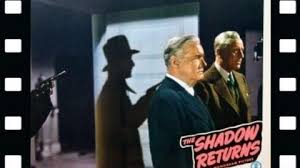The Shadow Returns 1946
IMDb meta-data is 1 hour and 1 minute run time, rated 5.7 by 128 cinematizens
Genre: Howdunnit (not Whodunnit).
Verdict: All hat, no oil.
‘Who knows what evil lurks in the hearts of men? The Shadow knows!’
Unlike The Whistler, The Shadow did not need to spy on people to find out their secrets: he got up in the morning knowing them. Moreover, The Shadow had ‘the power to cloud men’s minds so that they cannot see him,’ completely unnecessary where the fraternity brothers are concerned, but handy nonetheless. Still it left the brothers wondering about women’s minds. Nor did The Shadow need a gimmicky off-key whistle like you-know-whom. Finally, he was voiced once by Orson “I am a Genius” Welles. It ran to 677 episodes from 1937 to 1954. Most of which have been lost to ravages of indifference. But some can be had from Audible.
What a pedigree to take to the movies! What a flop the movies were and are!
In the movies he knows from nothing and back again. His mind is the only thing clouded. His gimmick is a black cat suit for a costume party. He is surrounded by people who know his secret.
Lamont Cranston interferes in police investigations to the amusement of his uncle, the Police Commissioner. His faithful driver is an oaf. He ridicules his girlfriend, Margo Lane whose single contribution to proceedings is to wear silly hats. Yet this is the Shadow. Hardly! A mere silhouette of his radio self.

This Shadow is so pathetic he has to hold a gat on the cops while he explains things to them. Not a cloud in sight. However in this outing the police do figure it out and there is a nice scene toward the end when the Irish Inspector No-First-Name Cardona and Lamont piece it together based on nothing but the clock and the script.
But to back up: Four sneaky types fall off balconies to break their necks and die, apparent suicides. Each was alone when taking the concrete dive. No one pushed them. Were they drunk or drugged? No. Were they following a Des Moines Sky Mall map? No. Were they by some scriptwriting coincidence suicides? No. Were they raptured by the Kool Aid? No. What then?
That is intriguing but the weary and dreary direction undercuts the suspense. Later the explanation involves either Indiana (Jones) or Australia, sort of.
There is also a neat idea about a secret lab in a warehouse that is not integrated. The only critic linked to the IMDb entry who bothered to comment on it said the plot was ‘not wholly coherent,’ exemplifying understatement.

Kane Richmond as Lamont Shadow has the profile of a superman double, chiseled features, powerful jaw, a brow untroubled by thought, a masterful baritone voice, broad shoulders, an effortless glide of step, a toothy grin, and the confidence of a schoolyard bully. Yet, strangely, he has no presence on the screen.
Margo gets some compensation for the twenty-four carat sexism throughout. Her best line is a reply to Lamont is: ‘Don’t yell at me until after we’re married and then don’t you dare!’ Even better when Lamont is trying to open a safe with much manly posturing as he prepares to pick the lock, she reaches past him and opens the door which she had noticed was not closed but which Lamont had not, so busy was he preparing for his display of masculine genius. Hssss [sound of ego deflating].

On the radio The Shadow and The Margo were a team and all business but on film they seem to be auditioning for a comedy show on the way to a masked ball, and failing. There is much, too much, slapstick with the black costume that he always has handy. The comic relief is annoying as usual.
It is little wonder that translating this successful radio serial to film failed. The radio audience would have found it to be a failure as above. The scriptwriter used bait and switch, and the audience switched back to radio.

